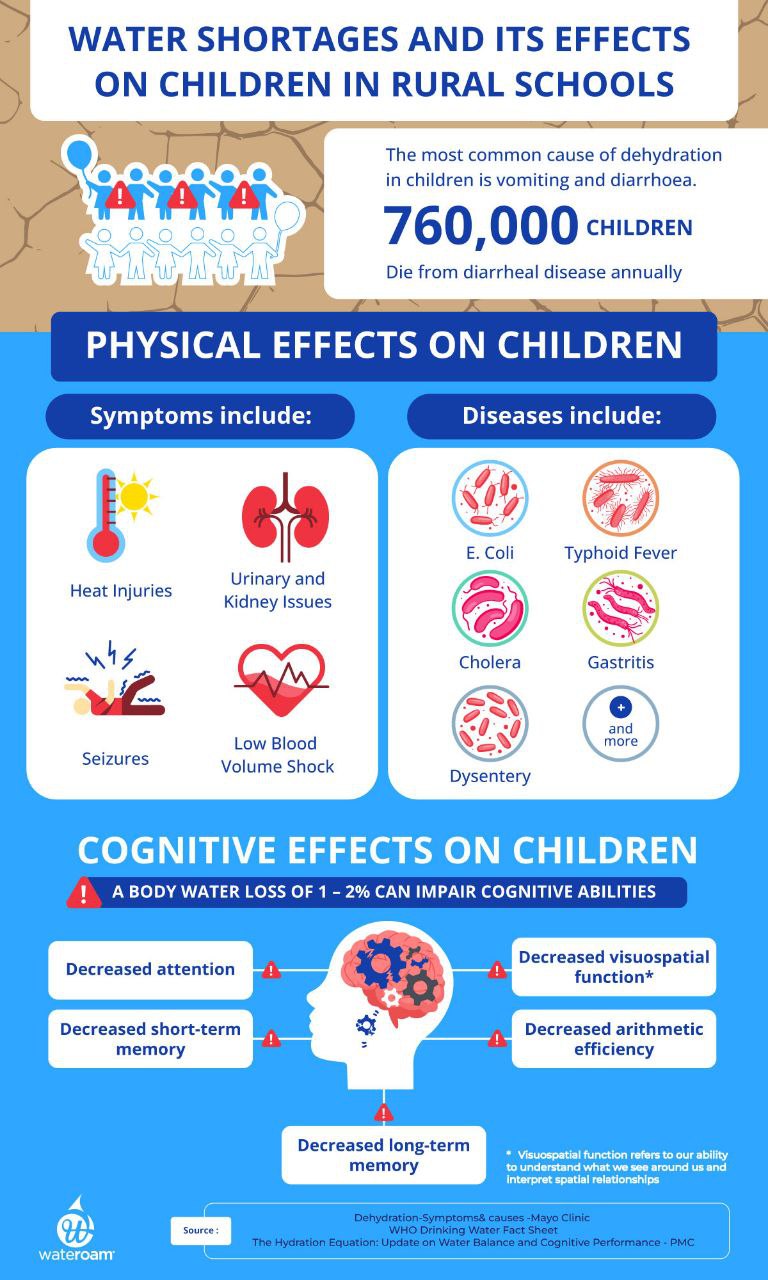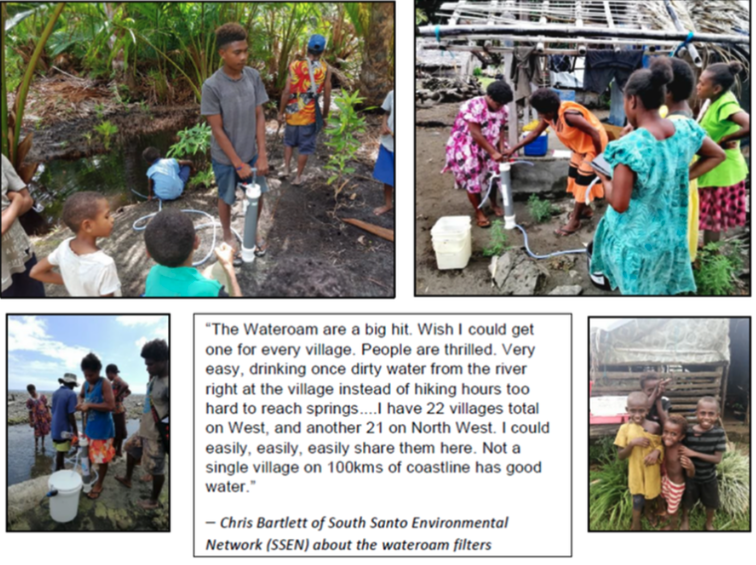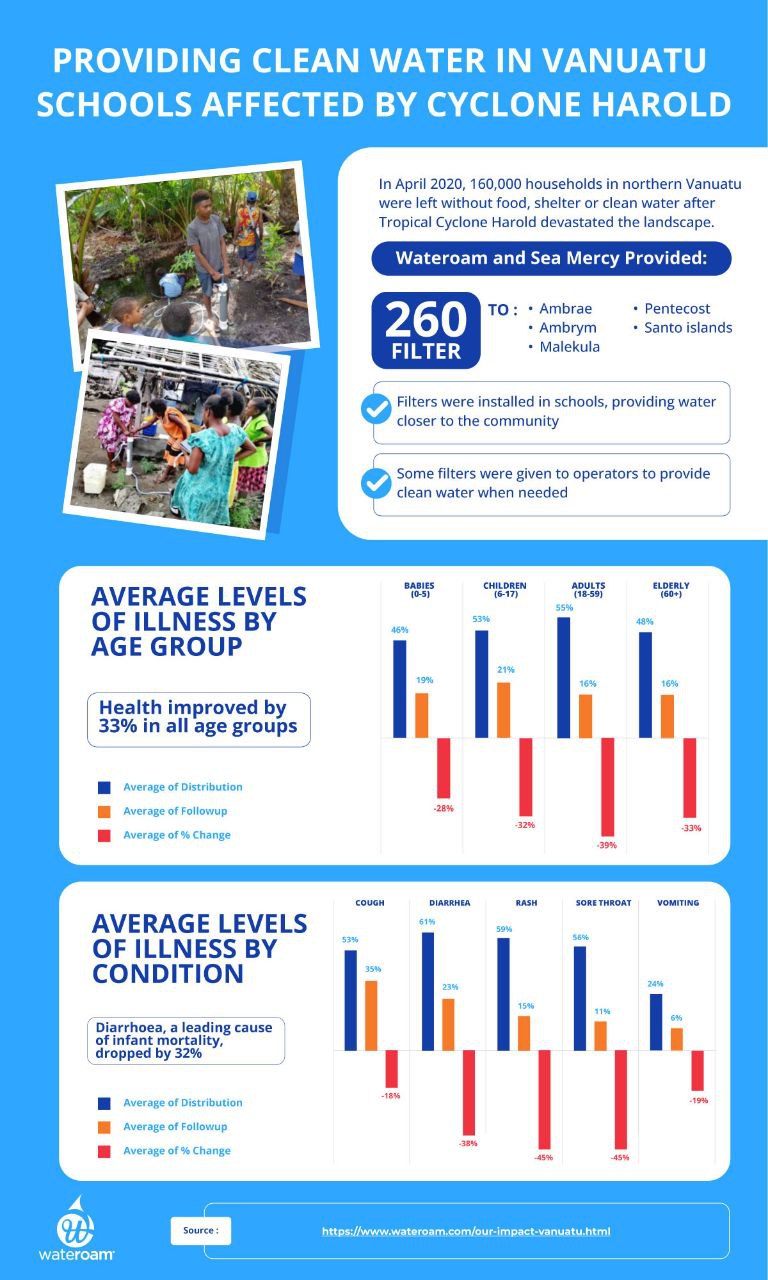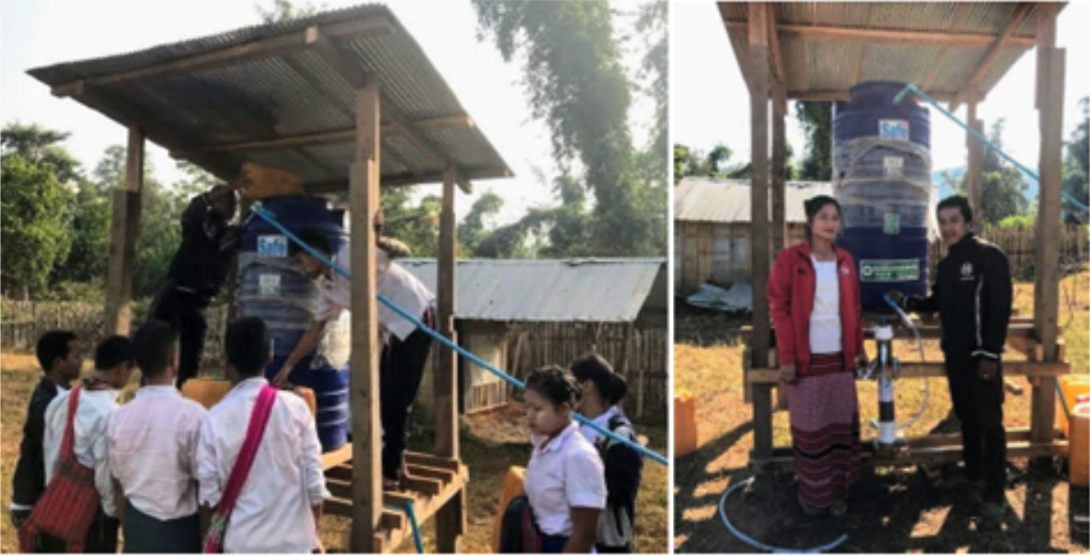Water Shortages and Their Effect on Children in Rural SchoolsWe'd like to thank you if you've contributed to or are part of organisations that bring clean water to those in need. During our research for this article, we realised that water shortages negatively affect every part of a child’s life, especially in rural areas. Any project providing clean and accessible water to these communities will improves their lives in almost every way. This article will briefly cover water shortages' impacts on rural school children before finishing with positive stories of people tackling this crisis. Physical Health ConsequencesDiarrhoea caused by drinking unsanitary water is one of the leading causes of dehydration in children. Vega & Avva(1)’s research on pediatric dehydration reports that: “Dehydration is a major cause of morbidity and mortality in infants and young children worldwide. Each year, approximately 760,000 children die of diarrheal disease worldwide. Most cases of dehydration in children are the consequence of acute gastroenteritis.” Dehydration also causes a whole host of symptoms. These include heat injuries, urinary and kidney problems, seizures, and low blood volume shock(2). Increased susceptibility to waterborne diseasesIn water-scarce regions, many communities may resort to unsafe water sources, putting many people at risk of contracting diarrhoea and other illnesses. These include E. coli, typhoid fever, cholera, gastritis, polio, dysentery, etc. (3) A lack of water also prevents effective hygiene and sanitation practices. Without clean water, sanitation and hygiene (WaSH) barriers, the chances of infection from the above waterborne diseases increase. Schools will go without running water, preventing children from washing their hands or cleaning up after defecation. Female hygiene and educationLacking access to clean water sources also disproportionately affects schoolgirls. Without clean water, girls who reach puberty will not only have insufficient hydration but additionally lack sanitation for their menstruation. This leads them to avoid attending school due to feelings of shame and anxiety, and when they venture out to fetch water for their families, they are also more susceptible to experiencing sexual harassment. We’re a social enterprise that believes in the impact of WaSH projects around the world, especially in schools and medical centres. You can watch us in action at a school in Bantar Gebang on Youtube or speak to us via the banner below: Cognitive Implications of Water Shortages on ChildrenDehydration affects children’s focus. Studies have shown that dehydration has the following effects: “Dehydration induced through exercise or heat stress has been associated with decreased short-term memory, long-term memory, arithmetic efficiency, visuospatial function, and attention.” (Chard et al 2019).(4) Even a body water loss of 1 – 2% can impair cognitive abilities (Riebl and Davy 2013).(5) If children can’t focus in school, they won’t benefit from their education which could extend the cycle of poverty in their communities. Social and Emotional EffectsIn some rural areas, fetching water can be time-consuming and dangerous. With parents needing to head out to work, children sometimes are responsible for fetching water. These trips become more dangerous if they compete with others for the same water source. As a result, children are exposed to interpersonal violence from water-related conflict and anxiety, resulting in increased physical, emotional, and sexual abuse. But these effects on children don’t just stop there. Family members suffering from preventable waterborne diseases also disrupt children’s development. If the adult responsible for fetching water falls ill, their child has to skip school to fetch water instead of receiving an education. Healthcare expenses will also skyrocket for affected households. The lack of clean water and reduced productivity in the community due to illnesses also lead to higher rates of developmental issues for children. Here is a brief compilation of psychological effects that water shortages cause children(6):
This means that any solution that can alleviate water shortages in schools can benefit not just the schoolchildren but the entire community. With access to clean water, waterborne diseases can be better managed, children need not risk dangerous trips to fetch water, school attendance improves, and adults can focus more on generating income without feeling anxious about their water supply. With that in mind, we’d like to share some stories of projects that improved the water supply of a few rural schools. How Organisations Are Addressing the Water Crisis in SchoolsOrganisations like WHO, UNICEF, Compassion International, Wahana Visi Indonesia and more have been organising projects to solve water shortages for children. Known as water, sanitation and hygiene (WaSH) programmes, they aim to provide clean water and educate communities on good hygiene and sanitation practices. This holistic approach makes each project's positive effects sustainable as the community can maintain the systems they now own and limit the spread of waterborne illnesses through proper hygiene. In April 2020, 160,000 households in northern Vanuatu were left without food, shelter or clean water after Category 5 Tropical Cyclone Harold devastated the landscape. Our partner, Sea Mercy, focused on providing safe drinking water to the affected communities through water filtration, desalination and water storage products. They deployed 260 of our ROAMfilter Plus systems across Ambrae, Ammbrym, Malekula, Pentecost and Santo. We designed our ROAMfilter Plus systems specifically for disaster relief and rural development situations. Using ultrafiltration pores sized at only 0.02 µm in diameter, our filters let water pass through easily while blocking 99.9999% of bacteria and viruses. We chose not to use nanofiltration because with pores that small, electrical pumps would be needed to squeeze sufficient water fast enough through the filters, which is not practical in rural settings. You can learn more about how our water filters work on our website. We’re glad to say that we’ve been able to impact the communities’ health positively: Health improved by 33% on average in all age groups between the time we distributed our filters and the next follow-up. This period saw a tremendous decrease in figures for diarrhoea, rash, sore throat, and vomiting. Considering how fatal diseases like diarrhoea can be when left untreated, this no doubt was able to save lives during this time. You can see more of our figures and impact in Vanuatu here. Our partner, Safe Water for Every Child - Myanmar (Safe Water) has also been working with us to provide clean water to different communities. Together, we installed 4 Wateroam filters in four villages in the remote mountains of MuTraw district, Karen State, Myanmar in 2021. Approximately 1,000 people now have reliable access to clean drinking water. Before receiving the filters, these communities faced waterborne diseases like diarrhoea, cholera, and polio, and absenteeism was common in schools. Htee Moo Khee High School has 185 students and 23 teachers who didn’t have access to safe drinking water. Safe Water worked with the students to build a tank stand and install the water filter. The teachers, with the support of the school committee, were assigned as caretakers of the water filter. The Safe Water coordinator also educated the community about WaSH habits and safe drinking water. The Nue Chatt La Middle School was another school that received a Wateroam filter. There are 275 people in the village, 80 students, and 5 teachers. Before receiving the filter, diarrhoea and seasonal cholera were common among the villagers, particularly children and older people. The Nue Chatt La Middle School is one of the only schools in the world teaching Karen history and culture with a program to preserve traditional sung poetry. Safe Water worked with the school to construct a tank stand and roof from bamboo. The students collected bamboo “bark” and heated it to make it flat to weave it into roof tiles for the filter building. Safe Water taught the teachers about WaSH procedures and how to maintain the filter daily. The students are also encouraged to carry water bottles to class for daily use. We and our partners are not the only organisations working to provide clean water to school children and communities. We want to give a shoutout to organisations like WHO, UNICEF, Compassion International, Wahana Visi Indonesia, and all the others that have been working to combat global water shortages. We hope that these stories have encouraged you and your team to continue to leave a positive impact on these children’s lives. If you’re interested in discovering more about our work or how our water filters can help your next project, reach out to us here: References:
0 Comments
|
Want more?Click below to see what other blog topics might peak your interest? 


|
- About Us
- Products
- Solutions
- Resources
- Get Involved
-
Blog
- The Global Water Situation
-
Facts about Water
>
- Water supplies for crisis
- WaSH During Emergencies
- Well Water Cleaning and Filtration Guide: Southeast Asia
- Gravity-fed Water Systems: Water Purification and Filtration setups in Southeast Asia
- A Guide to Rural Rainwater Harvesting and Filtering
- Water Shortages and Their Effect on Children in Rural Schools
- WaSH Planning and Design Framework Resources for Indonesia and the Philippines
- Rural Community Water Supply: Water Systems in Villages
- Info on our Products
- Impact Stories
- Upcoming & Past Events
- Contact
- Store
- About Us
- Products
- Solutions
- Resources
- Get Involved
-
Blog
- The Global Water Situation
-
Facts about Water
>
- Water supplies for crisis
- WaSH During Emergencies
- Well Water Cleaning and Filtration Guide: Southeast Asia
- Gravity-fed Water Systems: Water Purification and Filtration setups in Southeast Asia
- A Guide to Rural Rainwater Harvesting and Filtering
- Water Shortages and Their Effect on Children in Rural Schools
- WaSH Planning and Design Framework Resources for Indonesia and the Philippines
- Rural Community Water Supply: Water Systems in Villages
- Info on our Products
- Impact Stories
- Upcoming & Past Events
- Contact
- Store










.jpg)